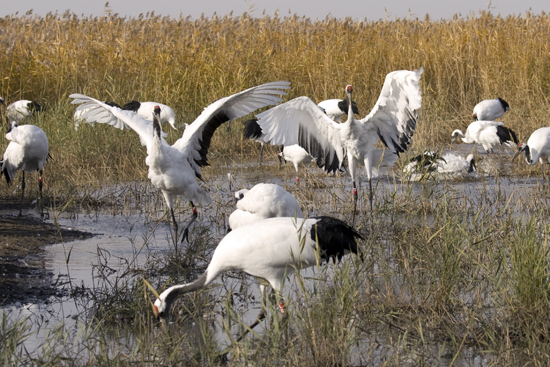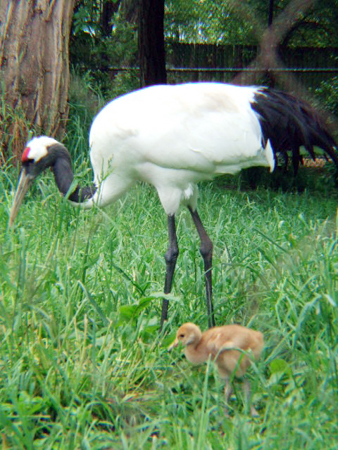National Symbols: National Bird
Red-Crowned Crane (common name)
Grus Japonensis (scientific name)
Designation
Official
Classification
- Kingdom: Animalia
- Phylum: Chordata
- Class: Aves
- Order: Gruiformes
- Family: Gruidae
- Genus: Grus
- Species: G. japonensis
The Bird
An endangered species, the red-crowned crane is one of the largest cranes, typically measuring 1.4 meters (4.6 feet) in length with a wingspan of 2.4 m (7.9 ft). Usual weight is 7–10 kilograms (15–22 lbs), with females being somewhat smaller than males. The crane is primarily a snowy white color with a featherless red patch on the head (the red “crown”), an olive-colored bill, a white band that extends from behind the eyes to the back of the neck, black underwing feathers, and long, black legs. Male and female cranes are very similar in appearance, although males have black cheeks and females have a grayish neck. The crane's red head patch changes to a darker color when the bird feels angry or excited.
Red-crowned cranes are wading birds that feed on amphibians and insects, and they often forage in deeper water than other cranes. In the summer they also feed in pasturelands. The birds are well-adapted to cold temperatures, which allows them to live and breed in chilly northeastern China, Russia, and Mongolia during the summer months. This species breeds in the spring and summer in deep-water marshlands in eastern China and both North and South Korea. They nest in areas of dead vegetation in coastal salt and freshwater marshes, rice paddies, fields, and rivers.
The Significance
In 2003 China's State Forestry Administration and the China Wildlife Protection Association began a search for a national bird, and the red-crowned crane won 65 percent of a public vote (the magpie and golden pheasant were other contenders). This tall, graceful crane is considered sacred in China, where it is a symbol of fidelity, good luck, love, nobility, and long life. It is also associated with birthdays and the New Year.
Taoist legends depict red-crowned cranes with immortality in stories where immortals ride on cranes. When used to represent long life, cranes are usually depicted in pairs alongside other longevity symbols (pine trees, peaches, or tree fungus). The crane is a common symbol on ancient Chinese bronze objects and is also a pervasive part of the design of more recent traditional ceramics, textiles, and painted scrolls.
With a declining population, the red-crowned crane is estimated at some 2,500 individual birds and has reached endangered status.
Copyright © 1993—2025 World Trade Press. All rights reserved.

 China
China 
